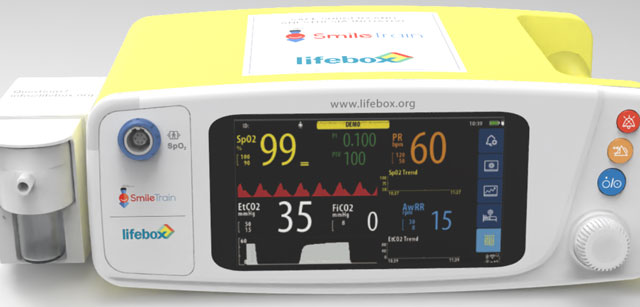
Smile Train and Lifebox advocate for the inclusion of a capnograph as an essential anaesthesia monitoring equipment for safer surgery
Singapore City, Singapore | THE INDEPENDENT | In a significant move to improve safety for millions of people undergoing surgery each year, Smile Train and global nonprofit, Lifebox, have come together to urge healthcare systems and equipment standard guidelines, to include a capnograph as an essential anaesthesia monitoring equipment for safer surgery.
Demonstrating their commitment to closing the global capnography gap, Smile Train, the world’s largest cleft-focused organization this week announced they would be donating additional capnographs valued at over $300,000 to their partner hospitals around the world.
This brings Smile Train’s total commitment to delivering capnography to well over $600,000, not counting the leadership investment made in bringing the project to fruition.
“Through our partnership with Lifebox, we have seen firsthand the lifesaving impact of capnography in surgical settings,” said Susannah Schaefer, President and CEO of Smile Train.
“We believe the inclusion of a capnograph by professional societies and national health authorities as an essential anaesthesia monitoring equipment in operating rooms will catalyze its adoption worldwide, ultimately saving countless lives,” Schaefer said.
Having a capnograph, Schaefer said, should be added as a must in surgery standard guidelines, including those set by the World Health Organization (WHO) globally.
What’s a capnograph?
A capnograph is the best tool for detecting a leading cause of anaesthesia-related complications and deaths in low-resource settings: the misplacement of the breathing tube supplying oxygen to the patient.
Without an oxygen supply, the patient will suffer catastrophic harm in a matter of minutes, including brain damage and death. The risk of a misplaced breathing tube is greater in children.
This vital tool has been a staple in operating rooms in high-income countries for more than three decades.
Its introduction in the United States in 1991 led to a dramatic decline in anaesthesia-related complications and deaths. Yet, capnography remains largely unavailable across most low-resource-setting operating rooms, with research showing there is often a 100% gap between the need for capnography and its availability in low-income countries.
“Working without capnography has been deeply concerning. It’s like navigating a dark path without a flashlight; you know the dangers are there, but you are unable to see them until it is potentially too late,” said Dr. Elizabeth Igaga, Director of Programs Safety at Smile Train.
“The absence of such a critical tool not only increases the risk to our patients but places an enormous amount of pressure on healthcare providers to anticipate, identify, and manage complications without delay. Including it in essential operating room equipment guidelines will revolutionize our approach to patient safety, allowing us to detect and respond to potential complications before they become life-threatening,”
The absence of capnography in most low-resource settings has been attributed to its high cost and the scarcity of devices adapted to specific local needs.
In response to this critical shortfall, Smile Train and Lifebox launched their Smile Train-Lifebox Capnograph is a high-quality, user-friendly, affordable capnograph with sturdy construction and long battery life suited for use in low-resource settings.
Working with the World Federation of Anaesthesiologists (WFSA), the Global Capnography Project (GCAP), and other leaders in global anaesthesia, the initiative also developed a comprehensive capnography training package for anaesthesia providers.
This year, 350 Smile Train-Lifebox Capnographs will be distributed in Benin, Ethiopia, the Philippines, and Uganda.
“Capnography shouldn’t be a privilege; it should be standard for surgical patient safety everywhere, and it is needed now,” said Lifebox Global CEO Kris Torgeson.
“Inclusion, for example, in operating room checklists as an essential piece of equipment would represent a monumental step in making surgery safer for every patient, regardless of where they live,”
This collaboration marks a pivotal moment in the global effort to enhance surgical and anaesthesia care, ensuring no patient is left behind due to a lack of access to essential health technologies.
The announcement was made during the 18th World Congress of Anaesthesiologists, taking place in Singapore from 3 – 7 March 2024, marking a critical moment in the global health stakeholders’ efforts to improve patient safety during surgery.
 The Independent Uganda: You get the Truth we Pay the Price
The Independent Uganda: You get the Truth we Pay the Price



